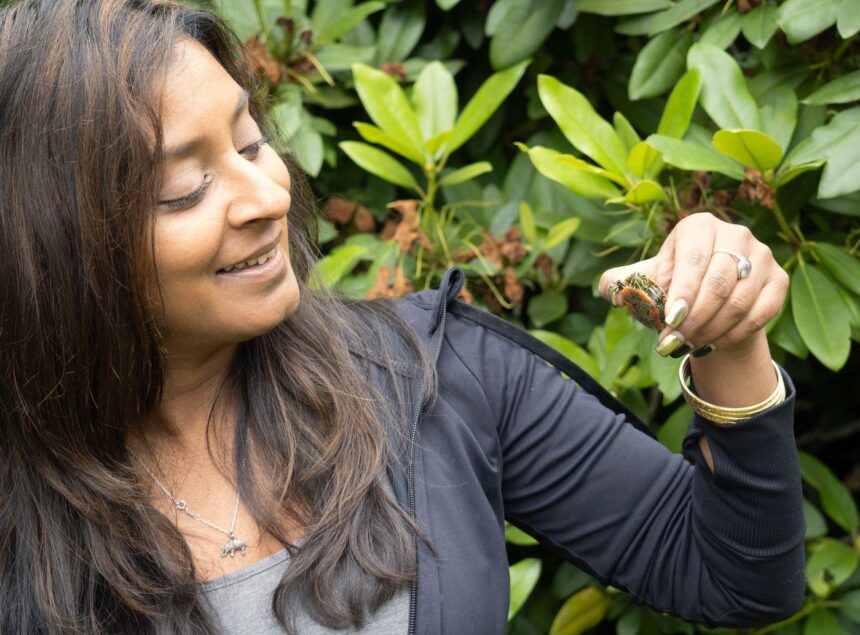The morning air hangs heavy with dew as Nicole Kroeker wades through knee-deep mud at Burnaby Lake. Her movements are deliberate, careful not to disturb the sensitive ecosystem that surrounds her. In her hands, she holds a small electronic tracking device, scanning for signals from the western painted turtles she’s been monitoring for the better part of a decade.
“Found one,” she whispers, more to herself than to me. I watch as she records data in a waterproof notebook, noting location, time, and environmental conditions.
Kroeker is the lead biologist for the Western Painted Turtle Recovery Project, a conservation initiative now celebrating its 10-year anniversary. The project represents one of British Columbia’s most sustained efforts to save its only remaining native freshwater turtle species.
“When we started in 2015, we couldn’t be certain we’d still be here a decade later,” Kroeker tells me as we move to drier ground. “But that’s what recovery of an endangered species requires – not just passion, but persistence.”
The western painted turtle, with its distinctive yellow stripes and red markings along the edge of its shell, once thrived throughout BC’s wetlands. Today, the Pacific Coast population is listed as endangered under Canada’s Species at Risk Act, facing threats that include habitat loss, road mortality, and competition from introduced turtle species like the red-eared slider.
According to Environment and Climate Change Canada‘s latest assessment, the species has disappeared from approximately 40% of its historical range in southwestern BC. The decline represents not just the loss of a species, but the unraveling of wetland ecosystems where these turtles play crucial roles in seed dispersal and controlling aquatic vegetation.
“Turtles are like wetland engineers,” explains Dr. Pamela Zevit, Program Coordinator with the South Coast Conservation Program, which partners with the recovery effort. “They’re what we call an umbrella species – when you protect them, you end up protecting entire ecosystems and the services those ecosystems provide to communities.”
I spent three days with the recovery team across different sites in the Lower Mainland and Fraser Valley, witnessing firsthand the meticulous work involved in bringing a species back from the brink.
At a protected nesting beach near Aldergrove, I watch as team members carefully excavate wire cages that were installed months earlier to protect turtle eggs from predators. The excitement is palpable when they discover successful hatches.
“Each baby represents hope,” says Andrea Gielens, a conservation specialist who oversees the project’s head-starting program at the Greater Vancouver Zoo. The program involves collecting eggs from vulnerable nests in the wild, incubating them under controlled conditions, and raising the hatchlings until they’re large enough to better survive predation when released.
To date, the program has released over 400 head-started turtles back into restored habitats. Recent population surveys suggest modest but meaningful recovery in several key locations, including Burnaby Lake, Aldergrove Regional Park, and wetlands within the Agricultural Land Reserve.
The work is not without challenges. Funding remains precarious year to year, and urban development continues to encroach on critical habitat. Climate change introduces new uncertainties, particularly as turtle sex determination is temperature-dependent during incubation.
“Warmer temperatures produce female-biased clutches,” Kroeker explains. “We’re already seeing shifts in sex ratios at some sites, which could affect long-term population viability.”
What makes this conservation story remarkable isn’t just the biological achievements, but the community engagement it has inspired. The project has trained over 200 citizen scientists who contribute thousands of observation hours annually. Local First Nations, including the Katzie, Kwantlen, and Stó:lō, have integrated western painted turtle monitoring into their environmental stewardship programs.
“This isn’t just about saving turtles,” says Brandon Gabriel, an artist and knowledge keeper from Kwantlen First Nation who has been involved with the project since 2018. “It’s about reconnecting people with the land and water in ways that honor traditional relationships.”
Gabriel has worked with the recovery team to incorporate Indigenous knowledge into habitat restoration efforts, drawing on centuries of observation about how turtles interact with their environment.
“My grandparents talked about these turtles being abundant when they were young,” he tells me as we walk along a restored shoreline. “They were part of our stories, our understanding of the world. Seeing them disappear has been like watching our history fade away.”
The project’s success stems partly from its collaborative approach. The Wildlife Preservation Canada coordinates efforts between the BC Ministry of Environment, Metro Vancouver Parks, the Greater Vancouver Zoo, local conservation groups, and academic researchers from the University of British Columbia and Simon Fraser University.
Dr. Andrea Norris, a conservation geneticist at UBC who studies the population structure of the remaining turtles, emphasizes the importance of this interdisciplinary approach. “Recovery work for long-lived species like turtles requires institutional memory and knowledge transfer that matches the lifespan of the animals themselves,” she says.
Western painted turtles can live up to 50 years in the wild, with females taking 7-10 years to reach reproductive maturity. This slow life history means recovery is necessarily a long-term commitment.
The project’s next phase aims to establish self-sustaining populations at five additional sites across the Lower Mainland by 2030, along with expanded habitat protection measures and road mitigation infrastructure to reduce mortality.
On my final day with the team, I join volunteers constructing artificial nesting beaches at a restored wetland near Chilliwack. The work is labor-intensive – mixing specific ratios of sand and soil, ensuring proper drainage and sun exposure, installing protective fencing.
Sixteen-year-old Ava Chen, who has been volunteering with the project for three years, carefully rakes the surface of the completed beach. “I might not see the results of this work for years,” she says, “but knowing I’m helping something that’s been around since dinosaur times feels important.”
As we finish for the day, a painted turtle surfaces briefly in the adjacent pond, its red-striped head visible for just a moment before disappearing beneath the water. It’s a fleeting glimpse of what recovery looks like – not dramatic or immediate, but patient and persistent.
“Sometimes conservation success isn’t about spectacular comebacks,” Kroeker reflects as we pack our gear. “Sometimes it’s about holding the line, giving a species the time and space it needs to recover on its own terms.”
For BC’s western painted turtles, that slow and steady approach seems to be working.






